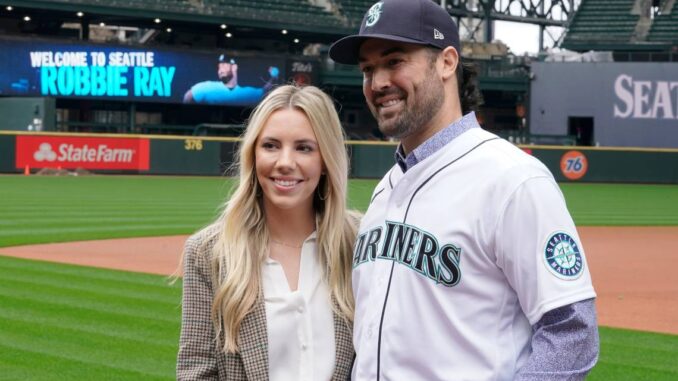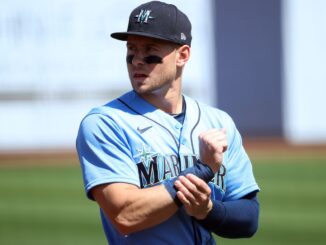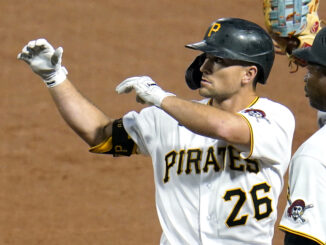
Adding A Current Record Holder
The Nationals drafted Robbie Ray in 2010. In the minors, he wasn’t his overpowering self, barely mustering a strikeout per inning. In 2013, Ray was traded to the Tigers and Steve Lombardozzi and Ian Krol for Doug Fister. Then, after a lackluster start to his career, Ray was a part of the deal that sent Didi Gregorius to the Yankees the following year. It wasn’t until 2016 when Ray started to see his success, more his strikeouts per nine (K/9), blossom. He hasn’t dipped from 11.3 K/9 since then, leading to the all-time Major League record for K/9 for a career, holding at 11.2. What earned Ray the Cy Young last year was his ability to control the walks finally. Going into 2021, Ray averaged 4.3 walks per nine innings. Last year, he almost halved that at 2.4 walks per nine, only walking 6.7% of batters faced. His increased velocity on his fastball-slider combo was the key to his success last year. Ray gained two miles per hour on his slider (an average of 88.6mph) and an extra mile per hour (94.8mph). Check out this nasty slider from last year:
State of the Starting Rotation
Last year, the Mariners were right around league average for almost every pitching statistic. There are two stats that I look toward to pitching success: Fielding Independent Pitching (FIP) and Earned Runs Average Plus (ERA+). FIP measures a pitcher’s ability to prevent home runs, walks, and hit by pitches while also causing strikeouts. The lower your FIP is, the better. Last year, the league average was 4.27, and the Mariners were slightly above average … at 4.26. ERA+ essentially adjusts every earned run from the ballpark that the game occurs in and who the team goes against. The league average is 100 every year, and the higher you go, the better. The Mariners were 19th at 98 ERA+. To summarize the nerd speak, the Mariners were your league average team at pitching last year.
The starting rotation, by innings pitched in 2021, was:
- Chris Flexen – 179.2 IP
- Yusei Kikuchi – 157.0 IP
- Marco Gonzales – 143.1 IP
- Logan Gilbert – 119.1 IP
- Justus Sheffield – 80.1 IP
- Tyler Anderson (Received in trade from Pirates) – 63.2 IP
- Justin Dunn – 50.1 IP
Going into 2022, the Mariners lost Kikuchi, declining his player option. While Kikuchi was an All-Star last year, his performance post-All-Star break should make Mariners fans happy he did not opt-in. Kikuchi gave up a .300 batting average (BA) and a .370 batting average on balls in play (BAbip) in 58.2 IP, with a subpar 5.98 ERA. Tyler Anderson, acquired in the trade with the Pittsburgh Pirates that sent out two minor league players, was in the last year of his contract, so he’ll be a free agent. Much like Kikuchi, Anderson didn’t produce at a level that will sting the Mariners in not resigning him. Anderson had a 4.81 ERA and an ERA+ of 87 over 63.2 IP.
I’m speculating here, but here’s what should be the Mariners starting rotation in 2022:
- Robbie Ray
- Chris Flexen
- Marco Gonzales
- Logan Gilbert
- Justin Dunn
- Justus Sheffield/Yohan Rameriez/Matt Brash/Nick Margevicius
I feel it’s a big year for Sheffield. Coming off the worst season of his career, Sheffield posted a 6.83 ERA while hitting the bottom eighth percentile or lower in Hard-Hit %, xBA (league-worst .301), xSLG, Barrel %, K %, and Whiff %. On top of being pressured by Yohan Rameriez (who will most likely become a reliever), Matt Brash, and Nick Margevicius, Sheffield will have to prove he’s worthy of the starting rotation.
The Leadoff Hitter The Mariners Needed
We spoke about Adam Frazier in last week’s article and what he brought to the team, so this may be a review for some of you. The Seattle Mariners recently acquired Adam Frazier from the San Diego Padres by trading away outfielder Corey Ray and relief pitcher Ray Kerr. The Padres were in a spot where they had four players capable of playing second base (Jake Cronenworth, Ha-Seong Kim, Jurickson Profar, and Frazier) on their 40-man roster, so someone had to be moved. The Mariners jumped at the opportunity to add last year’s NL All-Star second basemen.
Currently, the Mariners hold two players on the 40-man roster that can fit into that second base position, Abraham Toro and Dylan Moore. While Moore started the season as the starting second basemen for the Mariners, the trade acquired Abraham Toro from the Astros in exchange for Kendall Graveman, and Rafael Montero put Toro into the second base spot, transforming Moore into a super-utility guy. However, the offensive numbers don’t jump off the paper between Moore and Toro. Toro produced a slash line of .252/.328/.367 with a .695 OPS, and Moore was worse off with a .181/.276/.334 slash line and an OPS of .610. I personally like Dylan Moore as a super-utility man, as he possesses a significant amount of power in his game. Toro is also only 24 years old, so he will still have time to develop.
Switching over to the newly acquired Adam Frazier, you will notice a shift in offensive styles. While Frazier will struggle to crack ten home runs, he gives you exactly what you would want as a leadoff hitter, which is contact. Last year, Frazier produced a slash line of .305/.368/.411/ and an OPS of .779, which is substantially better than Moore and Toro. For those that are a fan of Statcast, as I am, Frazier produces some great numbers. He was fifth among all players in strikeout and whiff percentage, meaning he rarely struck out and swung and missed the ball. He was also third among all second basemen in expected batting average (.287). Expected batting average (xBA) is a formula that calculates the batting average on a hit using launch angle and exit velocity. For comparison, The Mariners at second base last year struck out the eight most, a stat that will surely swing in the opposite direction next year. Here’s a look at how Toro, Moore, and Frazier match up:

While tracking defensive metrics used to be difficult, thanks to Statcast, they can track every movement that a fielder makes. Because of this, we’re able to finally see how players can field by using their position on the field, coupled with the batted ball, wrapped into a stat called Outs Above Average (OAA for short). Abraham Toro replaced Dylan Moore as the full-time second basemen after the trade. Moore was above average at second, posting a four OAA, meaning he saved four runs above an average second baseman. Insert Toro, and you get a steep decline to -6 OAA, which means he cost the Mariners six runs with his defensive play. Adam Frazier was a slightly above average second basemen last year, posting a two OAA. While I believe Moore is the better fit defensively at second, the overall game of Frazier far outweighs the tiny discrepancy in OAA.
Who Makes A Bigger Impact?
Adding Robbie Ray essentially covered the innings pitched by Yusei Kikuchi and Tyler Anderson departures and added more strikeouts, fewer walks, and longer starts. The Mariners still have issues at the back of their rotation, but honestly, which team doesn’t? Including Ray this year, it will take that rotation from an average one to an above-average rotation, eventually trickling that success into fresher relievers.
Last year, the Mariners were a below-average offensive team, especially at second base. Between Abraham Toro and Dylan Moore, they complied a .295 On-Base Percentage (OBP), 25th in the league. Enter in Adam Frazier, coming off a career year with a .368 OBP, known for his top-tier ability to make contact with the ball when he swings. Putting him at leadoff will undoubtedly boost the Mariners’ offense, especially with prospect Julio Rodriguez about to join Kyle Lewis, Jarred Kelenic, and Ty France.
Who makes a more significant impact? My gut pushed me to Ray right off before I wrote this. The Cy Young winner that essentially strikes out everyone he sees is an exciting player. However, once I went back into Adam Frazier’s impact, it made me pause. The Mariners honestly struggled at second and on offense, and I think they’ll add another offensive piece. With that being said, I give Robbie Ray a slight edge over Frazier. It’s hard to deny that the all-time career leader in K/9 won’t be the more impactful player. I look forward to seeing Ray torching the AL West in 2022.



